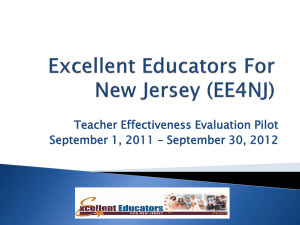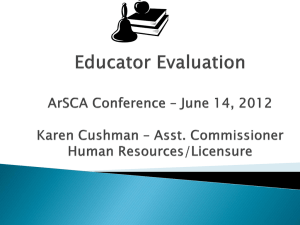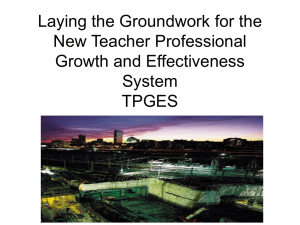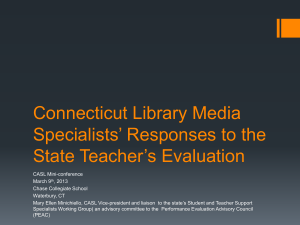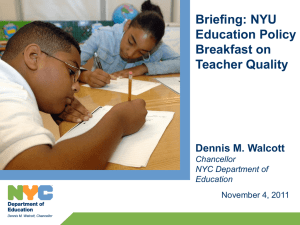EE4NJ-04.27.2012 - Foundation for Educational Administration
advertisement
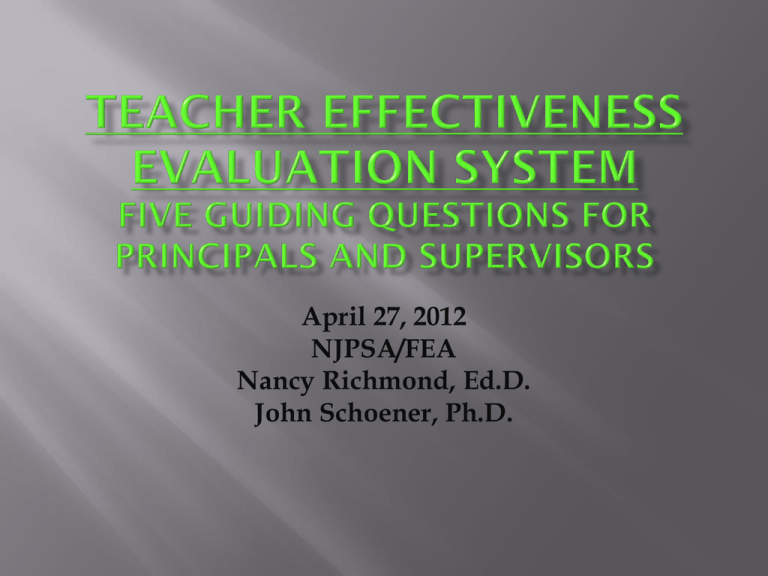
April 27, 2012 NJPSA/FEA Nancy Richmond, Ed.D. John Schoener, Ph.D. Superintendent? Principal? Assistant Principal? Supervisor? Director? Teacher? Board of Education member? Pilot One district? Pilot Two district? Not sure? On your table, please find a paper that says EE4NJ. Use one of the markers provided and write a word, a sentence, or a question that comes to mind when you think of the proposed Excellent Educators for New Jersey reform initiative. Do this without any conversation with your tablemates. Now share around the table what you wrote and why. As a group select one theme, pattern, or big idea that emerged from your table conversation that you can share with the large group. 1. 2. 3. What are the details and timelines of the new teacher evaluation system? What are the characteristics, implementation guidelines, and training opportunities of the state-approved teacher evaluation models? What should school leaders do now to begin a process of preparing for the 2012-2013 school year? Non-pilot districts Pilot Two Districts 4. What should principals and supervisors know about the student achievement measures that will be 50% of a teacher’s evaluation? 5. What do these changes mean to principals and supervisors in terms of their observation and feedback practices? The goal of NJPSA/FEA is to support school leaders in navigating through the NJDOE frameworks for the new teacher evaluation system. NJPSA/FEA has deep concerns about several aspects of the proposed teacher evaluation system. It is our responsibility to help you understand and respond to what is required by the State. Today will provide an opportunity for your voices to be heard. Nationally Teacher effectiveness is the most important in-school factor for improving student achievement. Traditionally teacher evaluation systems have not been designed to determine levels of effectiveness which differentiate a range of teacher performance. The Obama administration highlights teacher evaluation reform as a key commitment tied to federal policy and funding opportunities. At least 32 other states have recently changed their teacher evaluation systems. Troubling achievement gaps Current evaluations are subjective and fail to impact teaching 50% of college students never graduate 2010-2011 Governor’s Educator Effectiveness Task Force 2011-2012 Pilot One implemented 2012-2013 Capacity building for non-Pilot Two districts -------Or------ 2012-2013 Pilot Two implemented 2013—2014 Full roll-out and implementation in all districts Part 1 – Review what is expected of all districts in 2012-2013, including overview of models Part 2 – Explore what Pilot Two will look like for 2012-2013; react and respond. Part 3 – Consider how these changes will impact our observation and feedback behavior. Importance of meaningful and constructive conversations Stakeholder engagement is critical Evaluator and teacher training is critical Need to build basic assessment literacy and data analysis skills Need for proper evaluation of non-classroom teaching staff Workload increases for administrative staff Challenge in developing assessments for nontested grades and subjects Trust and a sense of urgency are critical Capacity Building Requirements (from NJDOE Memo, March 28, 2012) Form a District Advisory Committee to ensure stakeholder engagement in evaluation reform Teachers from each school level in the district Central office administrators overseeing the teacher evaluation process Administrators conducting evaluations Superintendent Special education administrator Parent Board of Education member/s Representatives of other groups, at Superintendent’s discretion 2. By January 2013, adopt an evidence-supported teacher practice instrument and procedures for applying the instrument (handout page 8-9) 3. From January 2013 through August 2013, test and refine implementation of the observation instruments and rubrics Scales or dimensions that capture multiple and varied aspects of teaching performance Differentiation of a range of teaching performance Objective validation on the aspects of both concurrent and construct validity 4. By June 2013, thoroughly train teachers 5. By August 2013, thoroughly train observers 6. Progress Reports in January and June, 2013 Where are you now? What is next for your district or school? Share what your district has learned and completed so far. Charlotte Danielson’s Framework for Teaching Dr. Robert Marzano’s Causal Teacher Evaluation Model McREL Teacher Evaluation System Dr. James Stronge’s Model As a group, create a short list of what your district values with regard to selecting a teacher evaluation model… …about the process …about the product In your small group… Review the information about each model Identify at least one area of strength for each model Determine what questions you would ask the vendor about their model Task: In your small group read and discuss the following quotes about creating a sense of urgency (pages 15-16) Discuss: Which quote particularly resonates with your group? Is there a quote you do not agree with? Brainstorm: Create a list of activities which might be used to create a sense of urgency and build a foundation for change Convene a District Evaluation Advisory Committee Secure a Teaching Practice Instrument Develop and Implement a Communication Plan Coordinate Teacher Professional Development Developing Measures of Student Achievement for Tested and Non-Tested Grades and Subjects 1. 2. 3. 4. What do you see as the advantages of this pilot requirement? What do you see as the challenges of implementation of this requirement? What impact might this requirement have on the culture and climate of your school? What concerns/issues would you like brought to the attention of NJDOE about this requirement? Advantages For Special Education – there is now more accountability for teachers and students Testing non-tested areas will align/integrate curriculum Challenges Tiered percentages (Core vs. Non-Core) of how much student performance counts is problematic How about inclusive teachers? Who is responsible? Potential for animosity and for teachers to be unwilling to team teach. Regular Ed teachers who have inclusion students? What will be the impact? Snapshot vs. multiple indicators is problematic Growth? How to show growth with teachers whose students come in at high level – how much growth can they expect to see? PARRC assessments represents a major change; bad time to put so much weight/importance on the scores General shift in intensity of the testing – emphasis on testing, not on instruction Grade inflation Equity between CORE and non-CORE – 2 different kinds of tests – using a test for a purpose other than what it was designed Impact on culture Trust is compromised by the realities of these guidelines – cultural barrier – divisive situation Trust between co-teachers is compromised – who is responsible? Long-term – what will they do with these results? Will they be made public? Collaboration vs. personal accountability Talent pool – math and LAL – will disappear Merit pay? Undermines pipeline to principalship. Who will want to be a principal? CORE vs. non-CORE – more definition needed – Is it by Subject? Or Certification? Additional Concerns for NJDOE Pilot 1 concerns were not addressed in Pilot 2 How will findings from Pilot 2 be used? External evaluator? More definition is needed on this. Time? How will this be done by principals who are already overextended? Budget concerns – how will districts pay for this mandate? Misuse of tests - were not designed for this purpose Fairness across system Piloting changes like this should be done in State-controlled districts where there are not so many variables that cannot be managed. How will these data be used to improve teacher preparation? Formal Observations 1. 2. 3. 4. What do you see as the advantages of this pilot requirement? What do you see as the challenges of implementation of this requirement? What impact might this requirement have on the culture and climate of your school? What concerns/issues would you like brought to the attention of NJDOE about this requirement? Advantages Double-scored – no in-building bias Many new principals have inherited a tenure staff – now there is hope to take action. Increased shared responsibility Administrators spending more time in classrooms may result in fewer discipline issues Principals will be forced to become instructional leaders – more time in classrooms External evaluator – another view Decrease in Donaldson hearings – more than one eye on the teacher More time in classrooms will allow for curriculum monitoring and monitoring for implementation of common core Double evaluator – learn about other parts of district Challenges Time and resources/accountable for many other things 15-minute observation – how much can we infer from such a short time in the classroom ? Small district – where do we get the external evaluator? External evaluator – vendor? outsourced? How about teachers who are working with student teachers – how will the teacher’s observations be completed? It will be necessary to delegate to teachers former principal responsibilities External evaluator does not know school, context – “drive by” evaluations Impact on Climate Tiered system – different numbers for different teachers – this is divisive Resolving a conflict if there is a discrepancy on the double scoring No equity between teachers “Got-cha” mentality – increased presence in classrooms with “checklists” Increased “traffic” in classrooms will provide a disruption to students. Additional Concerns for NJDOE Does research support a model of using student performance and increased time in classrooms to improve teacher performance? Where is the evidence that this approach will improve teacher performance and student performance? Classroom Observations, Scoring, Feedback, and Support 1. 2. 3. 4. What do you see as the advantages of this pilot requirement? What do you see as the challenges of implementation of this requirement? What impact might this requirement have on the culture and climate of your school? What concerns/issues would you like brought to the attention of NJDOE about this requirement? Advantages Inter-rater reliability among observers Greater dialogue among observers – learning from each other Counts as two observations Challenges There will be major challenges around scheduling There will be a need for collaboration/making decisions about what should be addressed Post-observation conference? Together? More scheduling challenges. Culture/Climate Tone will change with two observers in classroom Community impact/smaller districts/much involvement with parents – time away from building Principals will still be held accountable for what happens in your building even if they are in other buildings doing observations Multiple observers during conference is intimidating Superintendent may lack of hands-on supervisory experience Additional Concerns for NJDOE Nothing additional What do these changes mean to principals and supervisors in terms of their observation and feedback practices? Performance Standard 3: Instructional Delivery The teacher effectively engages students in learning by using a variety of instructional strategies in order to meet individual learning needs. State what you observed Provide evidence to support your observation State the impact of what you observed Provide the opportunity for reflection and guidance Supervision that Improves Teaching and Learning An opportunity to reflect on our own thinking about supervision……… Nancy Richmond, Ed.D. 609-860-1200 X102 nrichmond@njpsa.org John Schoener, Ph.D. 212-666-3320 john@schoenerassociates.com
